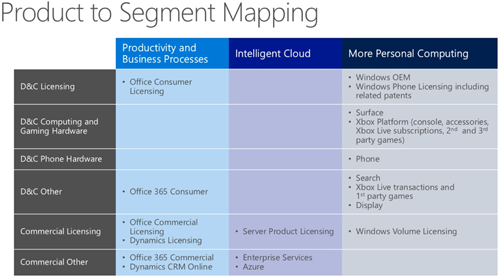News
Microsoft Reorgs Its Financial Reporting Structure
- By Kurt Mackie
- October 04, 2015
Starting this month, Microsoft's financial reports will have a new structure.
In announcement last week, Microsoft said it is changing its reporting structure to align its financial reporting with its CEO communications, something the company is required to do. In 2013, under former CEO Steve Ballmer, Microsoft instituted a financial reporting revamp, creating five business segments. Later, it added a sixth one. Now, under CEO Satya Nadella, Microsoft is planning to consolidate the current six segments into three segments.
The three new business segments, appearing in the next earnings report, will be as follows:
- Productivity and Business Processes, which includes Office commercial and consumer products and services, plus Dynamics products and services, and Office 365 services such as Exchange, SharePoint and Skype
- Intelligent Cloud, consisting of server products (such as Windows Server, SQL Server and System Center) plus services, as well as "Enterprise Services"
- More Personal Computing, which covers Windows, devices (Surface and phone), gaming (Xbox) and search.
This new structure will show up in Microsoft's fiscal 2016 Q1 earnings report, which is scheduled for publication on Oct. 22. However, the old report structure will accompany it for comparison purposes, although just for this Q1 quarter.
In a Sept. 29 conference call, explaining the changes, Microsoft published the following slide, showing how its old Device and Consumer (D&C), Commercial Licensing and Commercial Other segments map to the new reporting structure:
 [Click on image for larger view.] Microsoft's old financial reporting structure mapped to the three new business segments. (Source: Microsoft Investor Relations' Sept. 29 slide deck.)
[Click on image for larger view.] Microsoft's old financial reporting structure mapped to the three new business segments. (Source: Microsoft Investor Relations' Sept. 29 slide deck.)
Some distinctions seem to get blurred under the new reporting. For instance, the new structure combines consumer and business Office licensing. Chris Suh, Microsoft's general manager of Investor Relations, said during the conference call that Microsoft plans to break out some of those numbers. For instance, he said that Microsoft will report Office 365 consumer subscriber numbers in future reports.
The new reporting structure also appears to obscure Microsoft's server licensing numbers compared with its services subscription numbers. Suh said that Microsoft plans to report its "commercial cloud annualized revenue run rate" as a "quarterly metric" going forward. He also promised clarity on server products in coming reports, although Microsoft's past financial reports typically did not provide an exact breakdown on server numbers.
It appears that Microsoft will report Windows Phone earnings. In addition, that number will get bumped up with "related patents." Microsoft seems to have recently ended its legal skirmish with Google over mobile software patents. However, it continues to push its intellectual property claims in the space. For instance, the company this week announced an expanded cross-licensing deal with ASUS on Android-based tablets and phones. Part of the deal involves installing Office on ASUS Android-based devices.
Microsoft is continuing its "Corporate and Other" reporting segment, which is typically an expense segment rather than a revenue generator. However, in future reports, Microsoft plans to push information such as its "Windows 10 revenue deferrals" into that segment, according to Frank Brod, Microsoft's chief accounting officer, during the conference call. Typically, that's deferred revenue due to promotions and deals.
About the Author
Kurt Mackie is senior news producer for 1105 Media's Converge360 group.